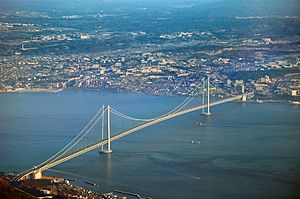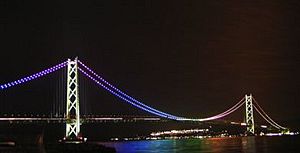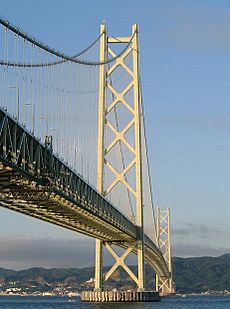Akashi Kaikyo Bridge facts for kids
Quick facts for kids Akashi Kaikyo Bridge明石海峡大橋 |
|
|---|---|

Akashi Kaikyo Bridge from the air, December 2005
|
|
| Coordinates | 34°36′58″N 135°01′14″E / 34.6162°N 135.0205°E |
| Carries | Six lanes of the |
| Crosses | Akashi Strait |
| Locale | Awaji Island and Kobe |
| Other name(s) | Pearl Bridge |
| Maintained by | Honshu-Shikoku Bridge Expressway Company Limited (JB Honshi Kōsoku) |
| Characteristics | |
| Design | Suspension bridge |
| Total length | 3,911 metres (12,831 ft) |
| Height | 282.8 metres (928 ft) (pylons) |
| Longest span | 1,991 metres (6,532 ft) |
| Clearance below | 65.72 metres (215.6 ft) |
| History | |
| Designer | Satoshi Kashima |
| Construction begin | 1988 |
| Construction end | 1998 |
| Opened | April 5, 1998 |
| Statistics | |
| Toll | ¥2,300 |
The Akashi Kaikyo Bridge (which means Akashi Strait Great Bridge in Japanese) is a huge suspension bridge. It connects the city of Kobe on Japan's Honshu island to Iwaya on Awaji Island. This amazing bridge is part of the Kobe-Awaji-Naruto Expressway. It crosses the Akashi Strait, a busy and sometimes rough body of water.
The bridge was finished in 1998. At that time, it had the longest central span of any suspension bridge in the world. Its main span is 1,991 meters (6,532 feet) long. Today, it is the second-longest, after the 1915 Çanakkale Bridge which opened in 2022. The Akashi Kaikyo Bridge is a very important part of the Honshū–Shikoku Bridge Project. This project created three main routes across the Inland Sea in Japan.
Contents
Building the Akashi Kaikyo Bridge
Why a Bridge Was Needed
The Akashi Kaikyo Bridge is a key part of a large bridge system. This system connects the islands of Honshu and Shikoku. The bridge crosses the Akashi Strait, which is about 4 kilometers (2.5 miles) wide. Before the bridge, people used ferries to cross this strait.
The Akashi Strait is known for strong winds, heavy rain, and storms. It is also a very busy shipping lane. Sadly, there were two big ferry accidents in the 1940s and 1950s. In 1945, the Sekirei Maru sinking killed 304 people. Then, in 1955, the Shiun Maru disaster killed 168 people during a storm. These tragedies made the Japanese government decide to build a bridge. They wanted to make travel safer across the strait.
Planning and Design
Engineers started looking into building a bridge in 1957. By 1961, a group of experts began a detailed study. They found that building a bridge across the Akashi Strait would be extremely difficult. It would face very tough conditions, unlike any other long bridge in the world.
In 1970, the Honshu–Shikoku Bridge Authority was created. This group did a lot of research. They even tested how to build foundations underwater. In 1973, a bridge design with a 1,780-meter (5,840-foot) central span was approved. However, construction was put on hold because of economic problems.
Construction Begins
Construction on the Akashi Kaikyo Bridge finally began in April 1988. The original plan was for a bridge that could carry both trains and cars. But the final design was only for a road bridge with six lanes. More than 100 different companies worked together to build it.
A major earthquake, the Great Hanshin Earthquake, hit in January 1995. This earthquake was very strong, but it did not cause much damage to the bridge. This was because of the special anti-earthquake building methods used. Construction finished on time in September 1996. The bridge officially opened on April 5, 1998. Japan's then-Crown Prince Naruhito and Crown Princess Masako attended the opening ceremony.
How the Bridge Is Built
Main Parts of the Bridge
The Akashi Kaikyo Bridge has four main parts that support it. Two are huge piers (towers) in the water. The other two are anchorages (large blocks) on land. These parts hold up the entire bridge structure.
The two main towers are in an area with very strong ocean currents. To protect them, special layers of rock were placed around their bases.
Bridge Spans and Towers
The bridge has three main sections, called spans. The central span is 1,991 meters (6,532 feet) long. The two side sections are each 960 meters (3,150 feet) long. The total length of the bridge is 3,911 meters (12,831 feet).
When the Great Hanshin earthquake hit in 1995, the two main towers had already been built. The earthquake actually moved the towers slightly. This meant the central span had to be made 1 meter (3.3 feet) longer than planned!
The bridge was built to handle very strong winds, up to 286 kilometers per hour (178 mph). It can also survive earthquakes as strong as magnitude 8.5. The two main towers stand 282.8 meters (928 feet) above the sea. Because of heat, the bridge can expand or shrink by up to 2 meters (6.6 feet) in a single day!
Each anchorage on land needed 350,000 tons of concrete. The steel cables that hold up the bridge are incredibly strong. Each cable is 112 centimeters (44 inches) thick. They contain 36,830 strands of wire, which would stretch for 300,000 kilometers (186,411 miles) if unraveled!
Lights on the Bridge
The Akashi Kaikyo Bridge has 1,737 lights! These lights are on the main cables, towers, and other parts of the bridge. Special lamps in red, green, and blue are on the main cables. Computers control these lights to create many different color patterns. There are 28 different light patterns used for holidays and special events.
Cost of the Bridge
The Akashi Kaikyo Bridge cost about 500 billion Japanese yen, which was about US$3.6 billion in 1998. To help pay for this huge project, drivers pay a toll to cross the bridge. The toll is 2,300 yen. About 23,000 cars use the bridge every day.
See also
 In Spanish: Gran Puente de Akashi Kaikyō para niños
In Spanish: Gran Puente de Akashi Kaikyō para niños
- Rainbow Bridge (Tokyo)




